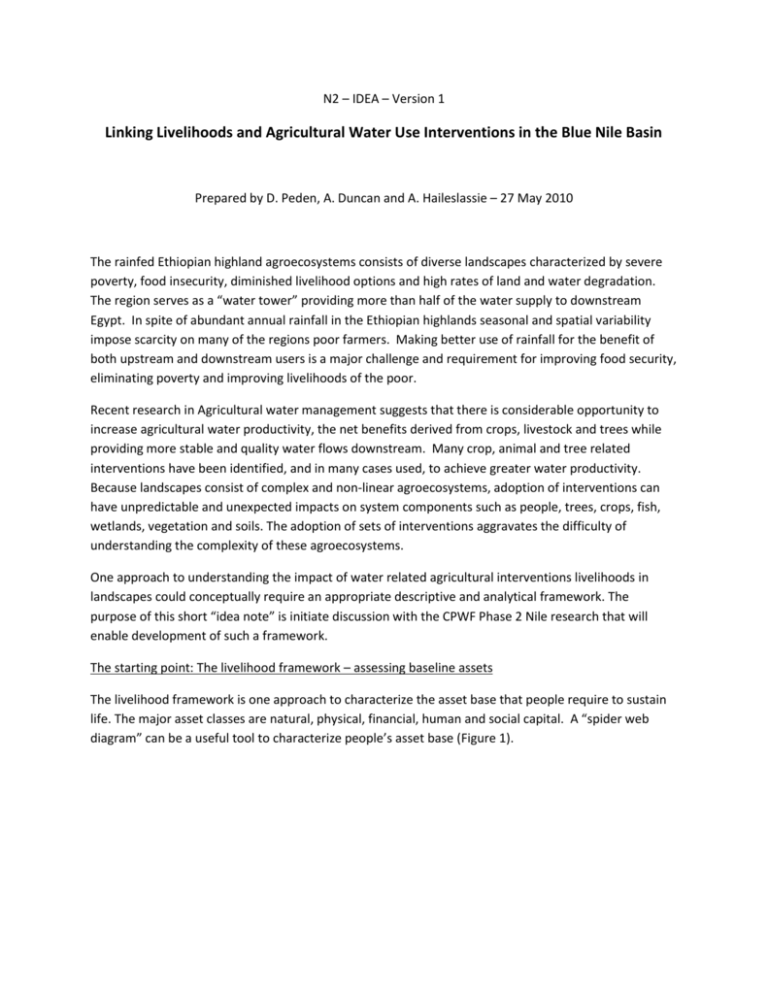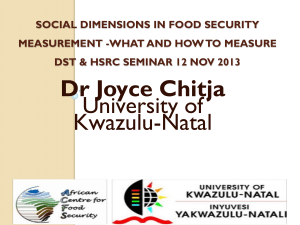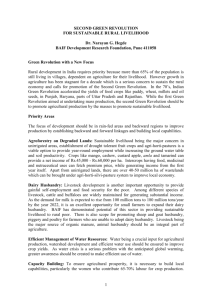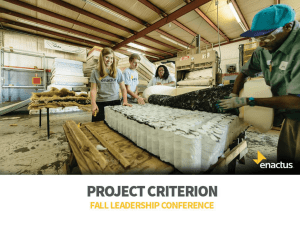N2 Idea note - 270510
advertisement

N2 – IDEA – Version 1 Linking Livelihoods and Agricultural Water Use Interventions in the Blue Nile Basin Prepared by D. Peden, A. Duncan and A. Haileslassie – 27 May 2010 The rainfed Ethiopian highland agroecosystems consists of diverse landscapes characterized by severe poverty, food insecurity, diminished livelihood options and high rates of land and water degradation. The region serves as a “water tower” providing more than half of the water supply to downstream Egypt. In spite of abundant annual rainfall in the Ethiopian highlands seasonal and spatial variability impose scarcity on many of the regions poor farmers. Making better use of rainfall for the benefit of both upstream and downstream users is a major challenge and requirement for improving food security, eliminating poverty and improving livelihoods of the poor. Recent research in Agricultural water management suggests that there is considerable opportunity to increase agricultural water productivity, the net benefits derived from crops, livestock and trees while providing more stable and quality water flows downstream. Many crop, animal and tree related interventions have been identified, and in many cases used, to achieve greater water productivity. Because landscapes consist of complex and non-linear agroecosystems, adoption of interventions can have unpredictable and unexpected impacts on system components such as people, trees, crops, fish, wetlands, vegetation and soils. The adoption of sets of interventions aggravates the difficulty of understanding the complexity of these agroecosystems. One approach to understanding the impact of water related agricultural interventions livelihoods in landscapes could conceptually require an appropriate descriptive and analytical framework. The purpose of this short “idea note” is initiate discussion with the CPWF Phase 2 Nile research that will enable development of such a framework. The starting point: The livelihood framework – assessing baseline assets The livelihood framework is one approach to characterize the asset base that people require to sustain life. The major asset classes are natural, physical, financial, human and social capital. A “spider web diagram” can be a useful tool to characterize people’s asset base (Figure 1). Table 1 gives some examples of the components of the major livelihood asset classes. There are four key points: First, livelihoods depend on both the magnitude of the assets relative needs and the balance among them. In principle, priority interventions will target the most limiting asset classes while still aiming to increase overall levels of assets. However, “low cost interventions”, could be efficiently applied to less limiting asset classes. Second, within this context, balance can also come about because people can exercise their limited options to take actions to shift the balance of their asset classes. For example, people with considerable access to cash or credit can purchase health (part of human assets) and fertilizer (to increase the productivity of a natural asset, soil). Third, it is not practical to attempt to assess all assets for all people. Multi-criteria analyses (MCA)1 can be used within participatory approach to enable focused research on the most important assets relevant to agricultural water management. Prioritization will be necessary. Fourth, there is need to emphasize gender differences in terms of access to livelihood assets. Van Hoeve and van Koppen pioneered an effort to integrate gendered livelihood approach into livestock water productivity assessments2. Natural 80 60 Social 40 20 Physical 0 Human 1 Before intervention After intervention Financial For example, see methodology developed by CIFOR at: http://www.cifor.cgiar.org/acm/methods/toolbox9.html. Van Hoeve E and van Koppen B. 2006. Beyond fetching water for livestock: A gendered sustainable livelihood framework to assess livestock-water productivity. In Proceedings of “Nile Basin Water Productivity: Developing a shared vision for livestock production”, a workshop of the CGIAR Challenge Program on Water & Food, 5-8 September, 2005 - Kampala, Uganda. Nairobi: ILRI. 2 Figure 1. Example of livelihood assets displayed using a "spider web diagram" and showing the kind of change one might expect after adoption of some beneficial intervention. Table 1. Examples components of the main livelihood asset classes (Source: http://www.ifad.org/sla/background/english/SLFramework.ppt, but other more formal publications are available). Natural capital Land and produce Water and aquatic resources Trees and forest Wildlife Livestock Wild food and fibres Physical capital Infrastructure (transport – roads, vehicles, etc.; secure shelter and buildings; water supply and sanitation; energy; communications Tools and technology (seed, fertilizer, tools for production) Indigenous technology Financial capital Savings Human capital Health Credit/debt Nutrition Remittances Education Pensions Wages Knowledge and skills Capacity to work Capacity to adapt Biodiversity Environmental services Social capital Networks and connections (patronage, neighbourhoods, kinship) Relations of trust and mutual support Formal and informal groups Common rules and sanctions Collective representation Mechanisms for participation in decision-making Leadership In the hypothetical example (Figure 1), the blue line shows what might be a baseline situation before adopting and intervention. The red line shows what might be considered adoption of a successful intervention because it has increased the total assets available and delivered greater balance among the asset classes. The implication is that in order to understand the impact of an intervention on livelihoods is that we need to assess the level and balance of the asset classes before and after the intervention. To the extent relevant, a gendered assessment is necessary. This gendered livelihood assessment must be integrated within the N2’s baseline assessment of learning sites with steps taken to spatially extrapolate such a survey to the broader landscape and river basin. The second step: Linking interventions to enhancement of asset classes A key purpose in developing, recommending and adoption water related agricultural interventions is to improve livelihoods. Based on the livelihood framework, this implies increasing the magnitude of each asset class (Natural, Physical Financial, Human and Social) and bringing about greater balance among them. Given the fact that many agroecosystems are chronically in a state of continuing degradation, simply stopping the yearly loss of assets such as soil fertility (natural capital) may be helpful but not be sufficient to improving livelihoods. Replenishment of soil fertility would be needed rather than just conserving the status quo. Consider an Ethiopian community that depends on a micro dam for domestic water supplemental irrigation of the command area downslope from the reservoir. One possible intervention could be adoption of a watering trough for livestock and preventing animal access to the riparian area. Conceivably this intervention could: 1. Improve natural capital by promoting water quality and riparian biodiversity by reducing transmission of water borne animal diseases, 2. Improve physical capital because the water trough would be part of the community’s physical capital and because increased riparian and buffering vegetation would reduce sedimentation of the reservoir, 3. Improve Financial capital because healthier animals would be more productive and people would spend less on medical care associated with consumption of contaminate drinking water, 4. Improve human capital through better human health associated with consumption of higher quality water, It is not impossible to envision a link between this intervention and increasing social capital but this writer could not think of an example. Wider consultation with communities and experts would be needed to identify important links between interventions and livelihood assets. MCA could be a useful tool to help identify priority interventions for various stakeholders. While the intent of promoting adoption of water related interventions is to increase the asset base of the poor, such adoption may not be possible in the absence of a minimal level of various assets. CPWF Phase 1 research demonstrated that water productivity was correlated with the magnitude of farmers’ wealth. It seems clear that farmers cannot adopt water productivity improving technologies if they do not have the financial capital available to make the investment. It is also likely that household plagued by poor health will have access to less labour required for intervention adoption. In communities lacking capacity for collective action, successful sharing and maintenance of the water trough may not be possible. Without adequate education and training (human capital), maintenance of the new watering trough may not be feasible. In brief, there will be a two-way linkage between asset accumulation and the adoption of water related technologies, policies and management practices. Successful interventions will help build the asset base. But these interventions cannot be adopted unless some minimal threshold of the poor’s asset base can be accumulated. We may need to consider existing agricultural practices (technology, management, policy, investment) as “interventions”. These may have both positive and negative impacts on livelihoods. The implication is that interventions may include the cessation of current inappropriate practices. For example, eliminating use of manure for fuel could free up this resource for soil fertility replenishment. Of course, alternative energy will be required. The third step: Developing an intervention-livelihood interaction framework. To meet CPWF objectives of identifying, developing and promoting interventions that can improve livelihood requires an analytical framework that helps assess the impact of the intervention (or sets of them) on the livelihood assets of the poor. It must also identify the prerequisite assets that poor farmers and communities must have in order to adopt the technologies. Gaps between available and required assets must be identified and closed for successful intervention. The strategy for filling such gaps will depend on the type of asset that not available to the farmer. For example, farmers’ lacking financial assets may need micro-credit. Farmers without adequate skills and education may benefit from special capacity building programs. Required livelihood asset classes Example interventions Natural Physical Financial Human Social Target livelihood asset classes Natural Conservation Agriculture Water troughs Water harvesting Physical Financial Human Social Figure 2. Prototype schematic of intervention & asset class linkages We have building blocks available for the intervention-livelihood framework but some additional data may be required. The challenge is to combine them in a practical way. Some key building blocks are: 1. Spatial data sets (GIS) to characterize spatial variability in livelihood assets, natural resources and drivers of change across the river basin. This will be needed to extrapolate knowledge generated at learning sites to the wider Blue Nile basin. 2. Livestock water productivity assessment framework. This was developed in CPWF PN37 with extension being developed within the CPWF BMZ project. 3. Gendered livelihood framework. This exists in diverse forms with the notable effort by van Hoeve and van Koppen (2005) to integrate interventions aimed at increasing LWP within the context of the LWP framework. 4. Water evaluation and planning system (WEAP). WEAP is a model developed by the Stockholm Environmental Institute (SEI) designed to serve as a robust but practical tool for integrated water resources planning. It facilitates engagement of diverse stakeholders in an open process and calculates water demand, supply, runoff, infiltration, crop requirements, flows, and storage, and pollution generation, treatment, discharge and instream water quality under varying hydrologic and policy scenarios. Proof of concept exists for using WEAP to assess the impact of agricultural water management on livelihoods. Some research effort will be needed to integrate up-to-date understanding of livestock-water interactions. 5. Multi criteria analysis (MCA). Limited resources dictated that N2 cannot consider all possible agricultural interventions and livelihood assets. Priority or case examples will be needed to make the research practical. The research challenge will be to integrate these and possibly other tools into systematic procedure to enable assessment of ex-ante and post-adoption impacts of agricultural water interventions on livelihoods. The fourth step: Application of the intervention-livelihood interaction framework In order to assess the potential effectiveness of water related agricultural interventions on livelihoods several data requirements must be met: N2 baseline (Year 1): 1. Assess livelihood assets at landscape and learning site scales and diagnose livelihood asset deficiencies. 2. Identify a menu of water related (direct and indirect) intervention options that can enable poor farmers and agricultural communities to overcome the diagnosed livelihood deficiencies. N2 framework development (Year 1): 3. Recruit either one PhD student or Post-doc to develop the modelling building blocks into the framework needed to assess the impacts of agricultural interventions on livelihoods. 4. In an ex-ante way, identify anticipated impacts the proposed interventions can be expected to have on farmers’ livelihood assets. 5. Estimate minimal thresholds of livelihood assets (or sets) to which farmers must have access in order to adopt and where relevant maintain interventions. Years 2-4: 6. Work with pilot site communities and farmers to implement selected interventions options (or sets thereof) using appropriate participatory, innovation systems, impact pathway and gender specific approaches. Where necessary find innovative means to ensure that participating farmers have means to meet prerequisite livelihood asset level necessary for adoption of intervention. 7. Monitoring and evaluation using the framework as a basis to determine the degree to which the interventions options (or sets thereof) actually have had on improving farmers’ livelihoods. 8. Use spatial analyses (GIS) to extrapolate findings to the Blue Nile River Basin. Outputs: 1. Description of potential intervention options that can help improve farmers’ livelihoods 2. Description of lessons learned as a result of farmers’ efforts to adopt interventions. 3. Farmers’ experience used to modify intervention adoption process. Outcomes: 1. Non-project farmers adopting water related agricultural interventions. 2. Non-farmer stakeholders such as Government agencies and NGOs applying project generated knowledge to help improve farmers’ livelihoods. 3. Uptake of approaches in other river basins or countries. Some research challenges: 1. Developing or adopting practical ways to assess farmers’ and communities’ asset base (MCA a candidate approach). 2. Ensuring appropriate and explicit inclusion of relevant gender issues. 3. Identifying spatial data requirements (GIS) to enable extrapolation to landscape and basin scales. 4. Integrate WEAP, livestock keeping, and the livelihoods framework, 5. Given that N2 is focused on landscapes, clarify the balance needed to meet both landscape and households’ needs. This may include expanding the framework to show how interventions will affect livelihoods of downstream water users or classes of people not involved in intervention adoption. More thought is needed about landscape questions to be addressed. 6. Develop an intervention data base (linked to GIS) that helps potential users determine appropriateness for the diverse condition and scales found in the Blue Nile highlands. 7. While not addressed herein, there is growing interest in taking an ecosystems approach and identifying the potential tipping points or triggers that can bring about rapid transformation of degraded agroecosystem to more sustainable and livelihood generating systems. These tipping points could be found within technology, policy, land tenure, and financial domains. Identifying and dealing with such tipping points might prove to be a very effective way of generating positive impact during N2’s lifespan.







